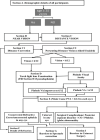Rapid survey for assessing effective cataract surgical coverage (eCSC) and effective refractive error coverage (eREC)-Novel indicators of universal eye health
- PMID: 38767538
- PMCID: PMC11552825
- DOI: 10.4103/IJO.IJO_1668_23
Rapid survey for assessing effective cataract surgical coverage (eCSC) and effective refractive error coverage (eREC)-Novel indicators of universal eye health
Abstract
Purpose: As per the recent World Health Organization estimates, approximately 2.2 billion people have near and distance vision impairment (VI) globally, and out of this almost 50% is avoidable.
Methods: The Rapid Assessment of Avoidable Visual Impairment survey was a cross-sectional study conducted in September 2021, using cluster random sampling in 42 clusters with a cluster size of 140, giving a total of 6000 participants. Two teams comprising of trained optometrists and social workers conducted the ocular examination which included unaided, pinhole, and aided visual acuity assessments followed by examination of the anterior segment and lens. Distance visual acuity was measured using simplified tumbling "E" charts of different sizes for VA of 6/12, 6/18, and 6/60. The lens assessment was done in an un-dilated pupil with torch light by the optometrist.
Results: Overall, 6520 individuals aged 6 years and above were enumerated, of whom 5440 (83.4%) were examined. The response rate for examination was better among females (93.1%) than males (73.9%), and it decreased from 93.8% in the age group 6-15 years to 77.1% in the 45+ age group. The prevalence of blindness and VI were 0.18% (95% CI: 0.06-0.29) and 4.19% (95%CI: 3.65-4.72), respectively. The major causes of VI in all age groups were uncorrected refractive error (65.4%), cataract (23.7%), cataract surgical complications (2.6%), corneal opacity (0.4%), and other posterior segment diseases (7.5%). The effective cataract surgical coverage (eCSC) was 61.8%, effective refractive error coverage (eREC) for distance vision was 59.8%, and eREC for near vision was 47.0%.
Conclusion: The RAAVI methodology is suitable to measure effective coverage in the general population, both for baseline measurement and periodic monitoring. The 2030 targets for the surveyed district are 90% eCSC and 100% eREC. Such exercises need to be conducted in each district of the country to determine the baseline and target values of effective coverage.
Copyright © 2024 Copyright: © 2024 Indian Journal of Ophthalmology.
Conflict of interest statement
There are no conflicts of interest.
Figures
References
Publication types
MeSH terms
LinkOut - more resources
Full Text Sources
Medical
Research Materials



